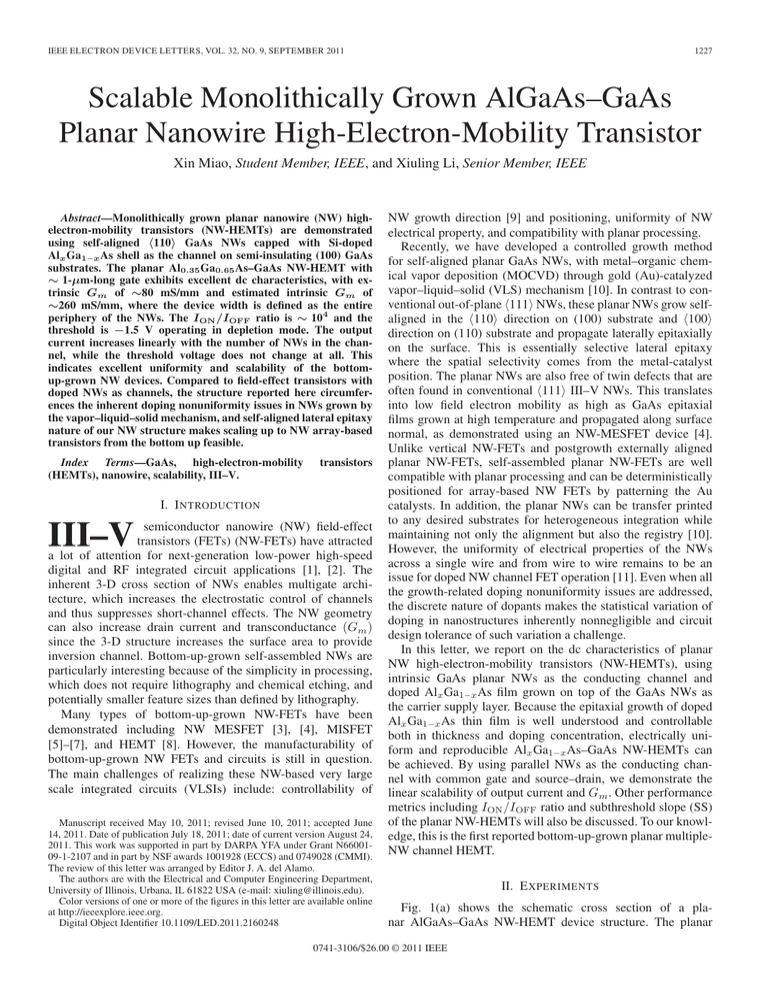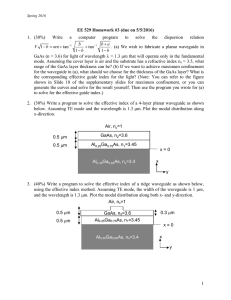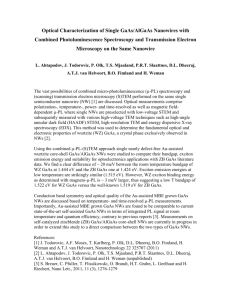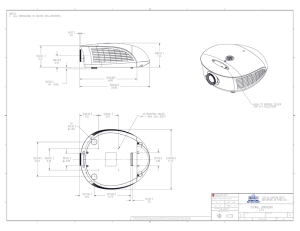Scalable Monolithically Grown AlGaAs–GaAs Planar
advertisement

IEEE ELECTRON DEVICE LETTERS, VOL. 32, NO. 9, SEPTEMBER 2011
1227
Scalable Monolithically Grown AlGaAs–GaAs
Planar Nanowire High-Electron-Mobility Transistor
Xin Miao, Student Member, IEEE, and Xiuling Li, Senior Member, IEEE
Abstract—Monolithically grown planar nanowire (NW) highelectron-mobility transistors (NW-HEMTs) are demonstrated
using self-aligned 110 GaAs NWs capped with Si-doped
Alx Ga1−x As shell as the channel on semi-insulating (100) GaAs
substrates. The planar Al0.35 Ga0.65 As–GaAs NW-HEMT with
∼ 1-μm-long gate exhibits excellent dc characteristics, with extrinsic Gm of ∼80 mS/mm and estimated intrinsic Gm of
∼260 mS/mm, where the device width is defined as the entire
periphery of the NWs. The ION /IOFF ratio is ∼ 104 and the
threshold is −1.5 V operating in depletion mode. The output
current increases linearly with the number of NWs in the channel, while the threshold voltage does not change at all. This
indicates excellent uniformity and scalability of the bottomup-grown NW devices. Compared to field-effect transistors with
doped NWs as channels, the structure reported here circumferences the inherent doping nonuniformity issues in NWs grown by
the vapor–liquid–solid mechanism, and self-aligned lateral epitaxy
nature of our NW structure makes scaling up to NW array-based
transistors from the bottom up feasible.
Index Terms—GaAs, high-electron-mobility
(HEMTs), nanowire, scalability, III–V.
transistors
I. I NTRODUCTION
III–V
semiconductor nanowire (NW) field-effect
transistors (FETs) (NW-FETs) have attracted
a lot of attention for next-generation low-power high-speed
digital and RF integrated circuit applications [1], [2]. The
inherent 3-D cross section of NWs enables multigate architecture, which increases the electrostatic control of channels
and thus suppresses short-channel effects. The NW geometry
can also increase drain current and transconductance (Gm )
since the 3-D structure increases the surface area to provide
inversion channel. Bottom-up-grown self-assembled NWs are
particularly interesting because of the simplicity in processing,
which does not require lithography and chemical etching, and
potentially smaller feature sizes than defined by lithography.
Many types of bottom-up-grown NW-FETs have been
demonstrated including NW MESFET [3], [4], MISFET
[5]–[7], and HEMT [8]. However, the manufacturability of
bottom-up-grown NW FETs and circuits is still in question.
The main challenges of realizing these NW-based very large
scale integrated circuits (VLSIs) include: controllability of
Manuscript received May 10, 2011; revised June 10, 2011; accepted June
14, 2011. Date of publication July 18, 2011; date of current version August 24,
2011. This work was supported in part by DARPA YFA under Grant N6600109-1-2107 and in part by NSF awards 1001928 (ECCS) and 0749028 (CMMI).
The review of this letter was arranged by Editor J. A. del Alamo.
The authors are with the Electrical and Computer Engineering Department,
University of Illinois, Urbana, IL 61822 USA (e-mail: xiuling@illinois.edu).
Color versions of one or more of the figures in this letter are available online
at http://ieeexplore.ieee.org.
Digital Object Identifier 10.1109/LED.2011.2160248
NW growth direction [9] and positioning, uniformity of NW
electrical property, and compatibility with planar processing.
Recently, we have developed a controlled growth method
for self-aligned planar GaAs NWs, with metal–organic chemical vapor deposition (MOCVD) through gold (Au)-catalyzed
vapor–liquid–solid (VLS) mechanism [10]. In contrast to conventional out-of-plane 111 NWs, these planar NWs grow selfaligned in the 110 direction on (100) substrate and 100
direction on (110) substrate and propagate laterally epitaxially
on the surface. This is essentially selective lateral epitaxy
where the spatial selectivity comes from the metal-catalyst
position. The planar NWs are also free of twin defects that are
often found in conventional 111 III–V NWs. This translates
into low field electron mobility as high as GaAs epitaxial
films grown at high temperature and propagated along surface
normal, as demonstrated using an NW-MESFET device [4].
Unlike vertical NW-FETs and postgrowth externally aligned
planar NW-FETs, self-assembled planar NW-FETs are well
compatible with planar processing and can be deterministically
positioned for array-based NW FETs by patterning the Au
catalysts. In addition, the planar NWs can be transfer printed
to any desired substrates for heterogeneous integration while
maintaining not only the alignment but also the registry [10].
However, the uniformity of electrical properties of the NWs
across a single wire and from wire to wire remains to be an
issue for doped NW channel FET operation [11]. Even when all
the growth-related doping nonuniformity issues are addressed,
the discrete nature of dopants makes the statistical variation of
doping in nanostructures inherently nonnegligible and circuit
design tolerance of such variation a challenge.
In this letter, we report on the dc characteristics of planar
NW high-electron-mobility transistors (NW-HEMTs), using
intrinsic GaAs planar NWs as the conducting channel and
doped Alx Ga1−x As film grown on top of the GaAs NWs as
the carrier supply layer. Because the epitaxial growth of doped
Alx Ga1−x As thin film is well understood and controllable
both in thickness and doping concentration, electrically uniform and reproducible Alx Ga1−x As–GaAs NW-HEMTs can
be achieved. By using parallel NWs as the conducting channel with common gate and source–drain, we demonstrate the
linear scalability of output current and Gm . Other performance
metrics including ION /IOFF ratio and subthreshold slope (SS)
of the planar NW-HEMTs will also be discussed. To our knowledge, this is the first reported bottom-up-grown planar multipleNW channel HEMT.
II. E XPERIMENTS
Fig. 1(a) shows the schematic cross section of a planar AlGaAs–GaAs NW-HEMT device structure. The planar
0741-3106/$26.00 © 2011 IEEE
1228
IEEE ELECTRON DEVICE LETTERS, VOL. 32, NO. 9, SEPTEMBER 2011
GaAs NW (i.e., the width of the top facet plus the two side
facets) is ∼450 nm, which is used as the channel width. Care
must be taken to ensure good interface quality between the
faceted GaAs NW and the AlGaAs shell, which determines the
density of the 2-D electron gas (2-DEG) for HEMT operation.
Taking advantage of the planarity and the epitaxial nature of
the NWs, we have cleaved the GaAs substrate normal to the
NW axial direction, to show the cross section of the NW-HEMT
structure. Citric acid : H2 O2 (4 : 1) was used to reveal contrast
between the Al0.35 Ga0.65 As thin-film shell and the GaAs NW.
As shown in Fig. 1(b), a void created from the removed GaAs
NW can be clearly seen underneath the top Al0.35 Ga0.65 As
layer which conforms to the crystal facet of the GaAs NW.
III. R ESULTS AND D ISCUSSION
Fig. 1. (a) Schematic illustration of a planar AlGaAs–GaAs NW-HEMT
structure with all the corresponding layers and metal contacts. (b) Tilted
SEM image of a planar GaAs NW uniformly covered with a ∼45-nm
Al0.35 Ga0.65 As film. The Au catalyst particle is at the far end. The planar
GaAs NW core and AlGaAs shell structure are confirmed by the void shown
at the cleaved end (front) where the GaAs NW is selectively etched by citric
acid : H2 O2 (4 : 1). Inset shows the schematic cross section with crystal facets
labeled. The width of the GaAs NW top facet is ∼140 nm, and the length of
each side facet is ∼155 nm.
NW-HEMT structure was grown monolithically in an Aixtron
200 MOCVD reactor using TMGa, TMAl, AsH3 , and Si2 H6
as precursors for Ga, Al, As, and Si. Au colloids of
20–250 nm diameter were randomly dispersed on GaAs surface before loading the substrates in the MOCVD reactor. Detailed growth procedure for the planar GaAs NW
has been described in detail previously [10]. Planar GaAs
NWs were first grown under atmospheric pressure at 460 ◦ C
using Au-catalyzed VLS mechanism on semi-insulating
GaAs (100) substrates with a growth rate of ∼68 nm/s.
The reactor pressure was then lowered to 100 mbar,
and the growth temperature was raised to 680 ◦ C to switch
from VLS NW growth mode (through Au) to epitaxial thinfilm growth mode for the AlGaAs shell deposition (Au stays at
the end of the NW and elevates to the top of the surface under
this condition). Specifically, 3-nm undoped Al0.35 Ga0.65 As was
grown as spacer directly on the GaAs planar NW top facets
and sidewalls, followed by 42-nm Si-doped (2 · 1018 cm−3 )
Al0.35 Ga0.65 As as the electron supply layer. Finally, 5-nm
n+ doped (> 2e18 cm−3 ) GaAs thin film was grown to cap
the AlGaAs layer and serve as source and drain ohmic contact layer. Si doping levels in AlGaAs were calibrated separately using standard planar thin-film growth. Fabrication was
done using conventional optical lithography. Source and drain
metal deposition was done right after growth using evaporated
Ge/Au/Ni/Au (20 nm/50 nm/30 nm/50 nm) stack followed by
annealing at 400 ◦ C for 15 s. Gate recess was done by selectively etching off the n+ GaAs layer over Al0.35 Ga0.65 As using
citric acid : H2 O2 (4 : 1). Ti/Au (10 nm/140 nm) gate metal was
evaporated thereafter without annealing. Mesa isolation or ionimplantation isolation step was not used.
The cross section of the planar GaAs NW is trapezoidal with
{111A} sidewall and (100) top facets, as schematically shown
in the inset in Fig. 1(b). Note that the entire periphery of the
Fig. 2(a)–(c) shows SEM images of three fully processed
AlGaAs–GaAs planar NW-HEMT devices that consist of single, double, and triple NWs as conducting channels, respectively. Gate metal contact conforms to the trapezoidal shape of
the NWs uniformly while source and drain appear more flat
due to annealing. The separation between source and drain is
5 μm, and the gate length is ∼1 μm. These NWs are of the
same dimension and perfectly parallel to each other owing to
their self-alignment to 110 crystal direction, so that electrical
characteristics should scale linearly as long as the electrical and
geometrical uniformity from NW to NW is granted.
Fig. 3(a) shows the measured source-to-drain two-terminal
I–V curves for three individual devices similar to those shown
in Fig. 2 before gate metal deposition. The current increases
linearly with voltage before reaching saturation, as reported
before [4]. Noticeably, the current level scales almost exactly
with the number of NWs in the channel. Fig. 3(b) shows the
output characteristics of the single, double, and triple channel
planar NW-HEMTs for Vgs = −1.5 to 0.5 V in steps of 0.5 V.
Well-defined linear and saturation regions are observed for all
devices, with a maximum output current of ∼100 mA/mm at
Vgs = 1 V when normalized to the channel width (the entire
periphery of NWs in channel) for the three devices, respectively. It is evident that the output current scales well as a
function of number of NWs in the channel of the three-terminal
devices. Fig. 3(c) shows the transfer characteristics of all three
devices, which show a clear threshold operating in depletion
mode. The threshold voltage −1.5 V is consistent with the
layer thickness and doping levels in the structure. For each
device, a group of three curves with drain voltage ranges from
1.5 to 2.5 V in steps of 0.5 V. At 1.5-V drain bias, Ids starts
to roll off at Vgs ∼ 1.5 V probably due to the gate leakage.
Extrinsic peak transconductances Gm,ext are 83, 84, and 86
mS/mm at 2.5-V drain bias for the single, double, and triple NW
channel devices, respectively. Source resistance of 8.13 Ω · mm
is extracted from two-terminal source-to-drain characteristics
shown in Fig. 3(a). The huge source resistance is probably
due to the thin GaAs cap, thick Al0.35 Ga0.65 As barrier layer,
and large gate-to-source distance, which holds large room for
improvement. Intrinsic peak transconductances Gm,int of 255,
265, and 286 mS/mm are estimated for the single, double,
and triple NW channel devices, respectively. ION /IOFF for all
devices is ∼ 104 as shown in the inset in Fig. 3(c), and SS is
in the range of 119–181 mV/dec. Both ION /IOFF and SS can
be readily improved using mesa etching or ion implantation
MIAO AND LI: SCALABLE MONOLITHICALLY GROWN AlGaAs–GaAs PLANAR NW-HEMT
1229
Fig. 2. SEM images of three fully fabricated AlGaAs–GaAs planar NW-HEMT with (a) single, (b) double, and (c) triple parallel NWs in the channel, respectively.
All NWs are of the same dimension as the one shown in Fig. 1(b). The scale bar represents 1 μm.
Fig. 3. DC characteristics of three AlGaAs–GaAs planar NW-HEMTs with single, double, and triple NWs in the channels. (a) Two-terminal source-to-drain
I–V curves before gate deposition for single, double, and triple NWs. (b) Output characteristics for Vgs = −1.5 to 0.5 V in steps of 0.5 V. Each set of color-coded
curves represent the data taken from devices with (bottom) single, (middle) double, and (top) triple NWs in the channel at the indicated Vgs . (c) Ids –Vgs transfer
characteristics for Vds = 1.5 to 2.5 V in steps of 0.5 V; Inset shows Ids –Vgs plot on a semilog scale. The gate length is ∼ 1 μm, and the channel length is 5 μm
for all devices.
TABLE I
DC P ERFORMANCE OF AlGaA S –GaA S P LANAR
M ULTIPLE -NW C HANNEL HEMT S
be built out of this planar NW-FET technology. RF performance
of planar NW-HEMTs using small NWs is being studied and
will be reported separately.
R EFERENCES
isolation. Table I summarizes all the dc performance metrics of
the planar multiple-NW channel HEMTs. The slight differences
in peak Gm , as well as output current among three devices, are
attributed to processing-related variations of gate length. The
excellent linear scalability demonstrated here will enable planar
NW array-based HEMTs with high output current.
IV. C ONCLUSION
In conclusion, we have reported the first bottom-up planar
NW-HEMT with monolithically grown multiple GaAs NW
channel and doped AlGaAs shell operating in depletion mode.
The demonstrated NW-HEMTs have excellent, uniform, and
scalable dc characteristics. With NW size scaling, improved
schemes for better source and drain contacts, self-aligned shortchannel processing, and reduced gate leakage by depositing
gate dielectric, the device performance is promising to surpass
its planar counterpart. Taking advantage of the distinctly small
width/length ratio of NW channel, enhanced gate controllability, low leakage current, high electron mobility, and versatile
drive current levels through the use of different number of NWs
in the channel, high-speed low-power mixed signal circuits can
[1] D.-H. Kim and J. A. del Alamo, “30 nm E-mode InAs PHEMTs for THz
and future logic applications,” in IEDM Tech. Dig., 2008, pp. 1–4.
[2] Y. Q. Wu, R. S. Wang, T. Shen, J. J. Gu, and P. D. Ye, “First experimental demonstration of 100 nm inversion-mode InGaAs FinFET through
damage-free sidewall etching,” in IEDM Tech. Dig., 2009, pp. 1–4.
[3] J. Noborisaka, T. Sato, J. Motohisa, S. Hara, K. Tomioka, and T. Fukui,
“Electrical characterizations of InGaAs nanowire-top-gate field-effect
transistors by selective-area metal organic vapor phase epitaxy,” Jpn. J.
Appl. Phys., vol. 46, no. 11, pp. 7562–7568, Nov. 2007.
[4] S. A. Fortuna and X. Li, “GaAs MESFET with a high-mobility selfassembled planar nanowire channel,” IEEE Electron Device Lett., vol. 30,
no. 6, pp. 593–595, Jun. 2009.
[5] Q. T. Do, K. Blekker, I. Regolin, W. Prost, and F. J. Tegude, “High
transconductance MISFET with a single InAs nanowire channel,” IEEE
Electron Device Lett., vol. 28, no. 8, pp. 682–684, Aug. 2007.
[6] C. Thelander, L. E. Froberg, C. Rehnstedt, L. Samuelson, and
L. E. Wernersson, “Vertical enhancement-mode InAs nanowire fieldeffect transistor with 50-nm wrap gate,” IEEE Electron Device Lett.,
vol. 29, no. 3, pp. 206–208, Mar. 2008.
[7] J. Xiang, W. Lu, Y. Hu, Y. Wu, H. Yan, and C. M. Lieber, “Ge/Si
nanowire heterostructures as high-performance field-effect transistors,”
Nature, vol. 441, no. 7092, pp. 489–493, May 2006.
[8] Y. Li, J. Xiang, F. Qian, S. Gradecak, Y. Wu, H. Yan, D. A. Blom, and
C. M. Lieber, “Dopant-free GaN/AlN/AlGaN radial nanowire heterostructures as high electron mobility transistors,” Nano Lett., vol. 6, no. 7,
pp. 1468–1473, Jul. 2006.
[9] S. A. Fortuna and X. Li, “Metal-catalyzed semiconductor nanowires: A
review on the control of growth directions,” Semicond. Sci. Technol.,
vol. 25, no. 2, p. 024 005, Feb. 2010.
[10] S. A. Fortuna, J. Wen, I. S. Chun, and X. Li, “Planar GaAs nanowires on
GaAs (100) substrates: Self-aligned, nearly twin-defect free, and transferprintable,” Nano Lett., vol. 8, no. 12, pp. 4421–4427, Dec. 2008.
[11] D. E. Perea, E. R. Hemesath, E. J. Schwalbach, J. L. Lensch-Falk,
P. W. Voorhees, and L. J. Lauhon, “Direct measurement of dopant distribution in an individual vapour–liquid–solid nanowire,” Nat. Nanotechnol.,
vol. 4, no. 5, pp. 315–319, May 2009.




